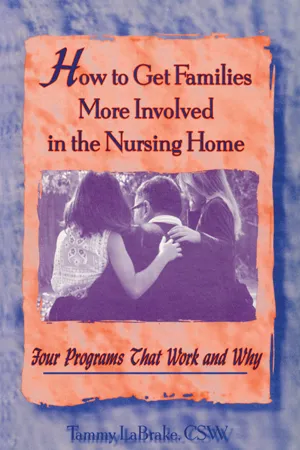![]()
Chapter 1
Educational Family Workshops
PURPOSE OF THE FAMILY WORKSHOP
• To affirm the value of staff/family interactions
• To provide basic information about topics related to aging
• To give the family techniques to make visits productive and meaningful
• To foster realistic expectations regarding services and provision of care in the nursing home
HELPFUL HINTS ON GETTING STARTED
Table 1.1. projects the needs of a Family Workshop and provides suggestions for creating an educational setting.
SUGGESTED TOPICS FOR THE WORKSHOP
One way of tailoring the workshop to meet the unique needs of the nursing home and its family population is to assess the interests of the family population. A survey completed by families will provide information regarding common interests and willingness to participate in a Family Workshop. A sample of a survey has been included in the Appendix. Keep in mind that a survey indicates interests, but not a commitment to actually attend a workshop. To determine if family members will come to a workshop, you must invite them. Send families invitations to attend a Family Workshop and ask them to RSVP, which will show an interest as well as a commitment to attend. A sample of an invitation to attend a Family Workshop can be found in the Appendix.
TABLE 1.1 Workshop Characteristics
Considerations | Suggestions | Anticipated Outcome |
physical setting | large conference room | good ventilation and space |
seating arrangements | tables with chairs | easy note-taking |
refreshments | cookies, fruit, beverages | energizing |
# invited to workshop | total family population | 15-33 percent response |
method of invitation | mailing with RSVP | promotes reserving seats |
duration of workshop | 2 hours | allows ample time for Q&A |
time/day of week | Sunday 2-4 p.m. | popular visiting day |
season | late winter | nonactive time of the year |
speakers | multidisciplinary | draw from expertise |
The workshop should be well structured with emphasis on the topics that family members indicated they were interested in learning more about. The outcome of assessing their interests is likely to involve the following topics:
• Stress Associated with Aging
• Making Visits Count
• Enhancing Staff/Family Communication
• Understanding Medicare and Medicaid
Topic 1. Stress Associated with Aging
The purpose of this topic is to help family members realize their own attitudes about aging and to discover ways to acknowledge the negative and positive aspects of aging. This particular topic is meant to be an educational experience for workshop participants as they consider their own aging. Little information focuses on the resident during discussions of this topic.
What You Need to Begin
1. Four multicolored index cards with the following incomplete sentences:
At the beginning of the session distribute the four cards to participants who are willing to read aloud to the group. Before beginning the session, ask all four people with a card to quietly read it to one other participant. This helps them feel more comfortable when they are later asked to read the card to everyone. They can also begin thinking about how to complete the sentence on the card.
2. An overhead projector to view transparency, “Stressors Associated with Aging.”
3. Fine-point markers for the overhead.
4. A poster with an outline of the four topics to be discussed.
5. An oven timer.
In order to keep the workshop within two hours, time frames are necessary. (The oven timer releases you from timekeeping duties and workshop participants are more at ease by knowing what time frames to expect.) Again, invoke participation by asking a family member to be responsible for the timer.
6. Three pieces of scrap paper and a pencil or pen for each participant.
7. Name tags for all attending.
Introductions
Encourage all participants, including staff members, to wear name tags. Before starting the workshop explain to the participants that you have invited several staff members to attend the workshop. Staff should be dispersed at different tables with family members. Formally introduce the staff by having them stand during introductions.
Members of the staff should include but not be limited to: the administrator; a physician assistant or nurse practitioner; a registered nurse, preferably the director of nursing; a dietitian; an occupational therapist and/or a physical therapist; a social worker, and a representative from the activities department. Then have each family member introduce him or herself. It is also helpful to have family members tell who their resident is and on which wing their resident resides.
Beginning the Topic
Topics related to aging can cause people discomfort. Because aging can be an uncomfortable subject, it is essential that families understand how their perceptions about aging influence the quality of their visits in the nursing home. As families become aware of their own fears and misconceptions about aging, they will become more comfortable during their visits. To begin this topic, ask the workshop participant who has card #1 to read it aloud:
The purpose of these cards is not to spend an inordinate amount of time discussing the card, but rather to keep the discussion focused and light. Ask participants to complete the sentence from card #1. For example, “If God had to make wrinkles … why didn’t he put them on the bottom of our feet!”
Your next opening statement should address the discomfort that discussing aging can cause. You could say, “Talking about getting old is not a very popular topic.” Begin a more in-depth conversation by asking some or all of the following questions:
• How many of you feel you are getting old? How many of you want to get old?
• How many of you feel that visiting a nursing home causes you to think about your own aging?
• In what way does this influence the quality of your visits?
• If folks have come to terms with their own aging, will they be more comfortable visiting a nursing home?
• If they have not come to terms with their own aging, are they likely to avoid spending much time in a nursing home?
• So, how does one come to terms with aging and the stress related to aging?
Share with the group that one way to come to terms with one’s own aging is to prepare for the stress that can be associated with the aging process.
Identifying the Stressors That Are Associated with Aging
Participants should already be divided into small groups with five to eight people at a table. Tell each table to assign a “leader” who will keep notes. Each staff member sitting at a table should offer support and help facilitate discussion when necessary. Instruct the participants at each table to discuss among themselves some of the stress they believe to be associated with aging. Set the timer and allow five minutes for discussion.
While discussion is taking place, you should give some direction to the participants by listing on an overhead transparency different categories of stress such as: SOCIAL STRESS, FINANCIAL STRESS, PSYCHOLOGICAL STRESS, STRESS OF BODILY CHANGES. To enhance visual effect, use different colored markers for each category.
When the timer sounds, remove the transparency of stress categories from the overhead and replace it with a more detailed description of the kinds of stress that can be associated with aging. It is easier and less time consuming to have a description of stressors associated with aging already printed and ready to use on an overhead transparency. C...



